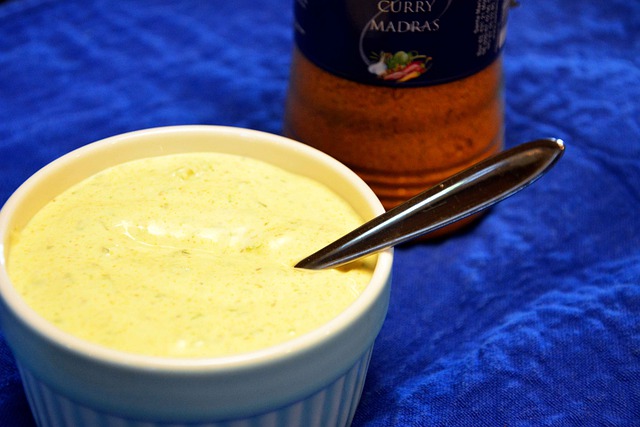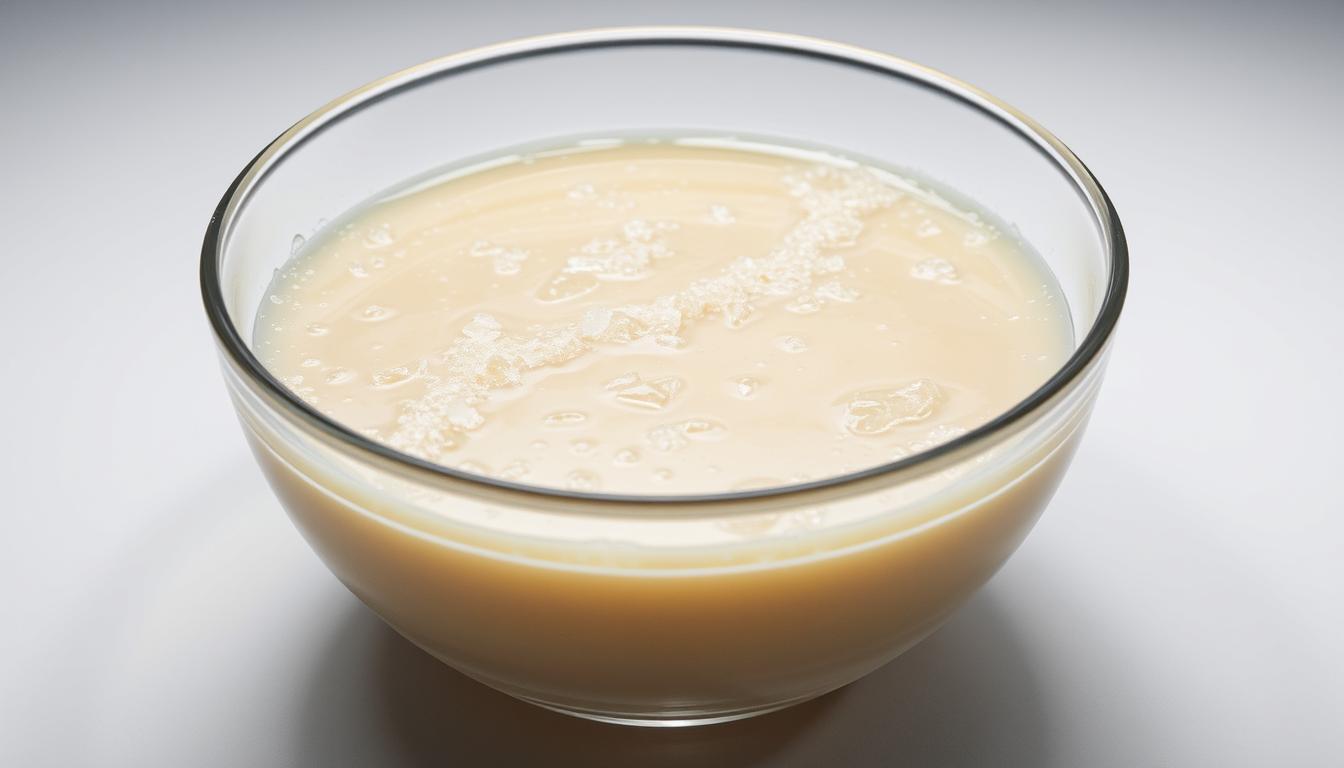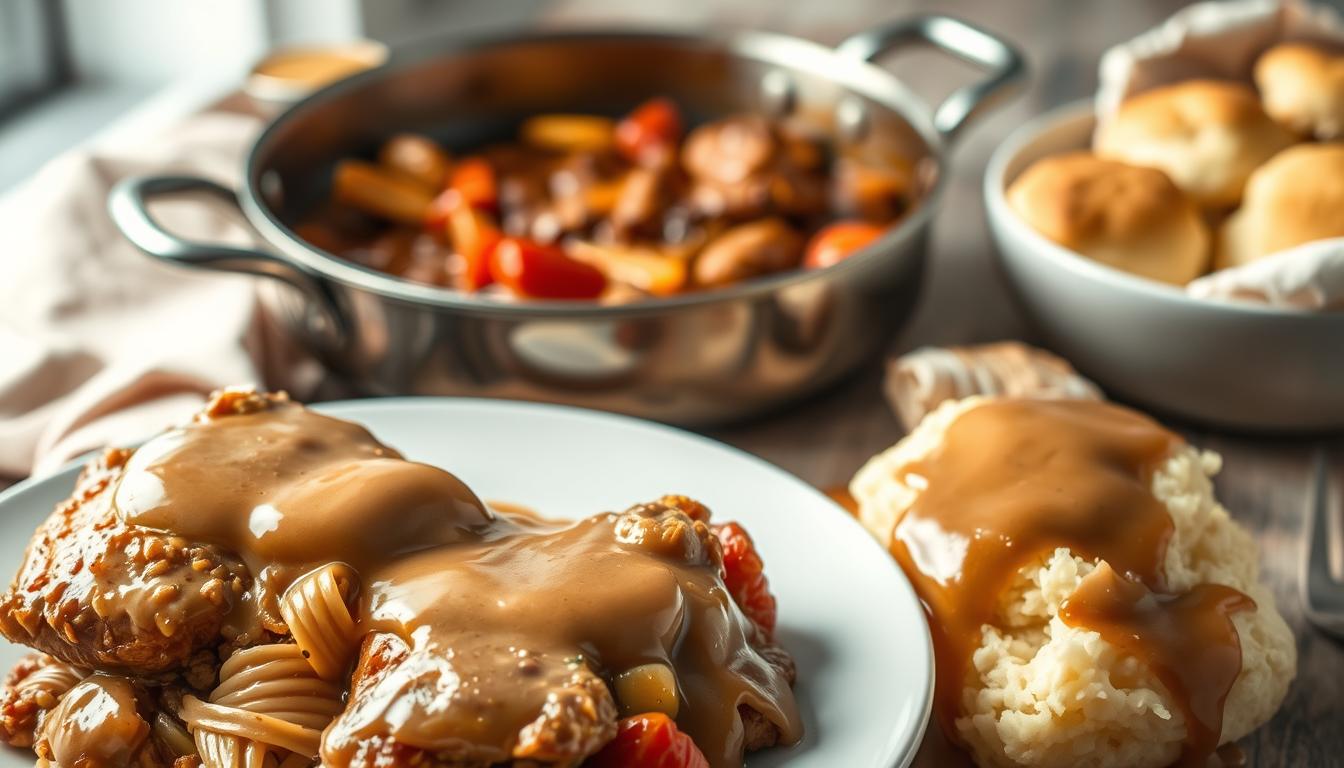Ever had leftover gravy and wondered if you can save it? Freezing is a way to keep food fresh longer. But, it works better with some ingredients than others.

Gravy thickened with cornstarch might freeze differently. Cornstarch is a common thickener. But, how it acts when frozen and warmed up is not always the same. This article will tell you if freezing works for cornstarch gravy and what to expect.
Key Takeaways
- Understand the effects of freezing on cornstarch-thickened gravy.
- Learn the best practices for freezing and reheating.
- Discover tips for maintaining the quality and texture.
- Explore alternatives to freezing if it’s not recommended.
- Find out how to properly store frozen gravy for optimal results.
Understanding Cornstarch-Based Gravy
Cornstarch gravy is a favorite for those who need gluten-free options. It comes from corn and is used in many dishes. This includes both savory meals and sweet desserts.
What Makes Cornstarch Gravy Different
Cornstarch gravy is special because it thickens well without changing the taste. This makes it a great choice for many recipes.
Chemical Properties of Cornstarch as a Thickener
Cornstarch has starch granules that soak up water and grow when heated. This makes the gravy thicker. It works best between 144°F and 180°F.
Cornstarch vs. Other Thickeners
Cornstarch makes a clearer gravy than flour. It’s also gluten-free, which is good for people with dietary limits. But, it can get cloudy if cooked too long or not mixed right.
Common Uses for Cornstarch Gravy
Cornstarch gravy is great for many dishes. It’s perfect for roast dinners and new recipes. It’s also good for those who can’t eat gluten.
Popular Dishes That Use Cornstarch Gravy
Many dishes use cornstarch gravy, like stir-fries and roasted meats. It’s especially loved in Asian cooking. It coats food well without hiding their taste.
Dietary Considerations (Gluten-Free Option)
Cornstarch gravy is great because it’s gluten-free. This is perfect for people with celiac disease or who eat gluten-free. Make sure all your gravy ingredients are gluten-free too.
Can You Freeze Gravy Made with Cornstarch?
Cornstarch gravy can be frozen. But, it’s important to know how the starch changes when it freezes. Freezing is a way to keep homemade gravy fresh. But, cornstarch gravies act differently when frozen.
The Short Answer
Yes, you can freeze gravy made with cornstarch. But, how well it stays good after thawing depends on how it was frozen. Proper freezing techniques help keep the gravy’s taste and texture.
How Freezing Affects Cornstarch Thickened Sauces
Freezing changes the starch molecules in cornstarch gravies. This can change how they feel. Knowing this helps you freeze your homemade gravy right.
The Science Behind Freezing Starch Molecules
Cornstarch thickens gravy by soaking up liquid and growing when heated. Freezing this mix changes the starch molecules. Ice crystals can mess up the starch network. This might make the gravy thinner or more gel-like when thawed.
What to Expect After Thawing
Thawed cornstarch gravy might not be the same. It could separate or feel different. But, sometimes, just stirring or heating it again can fix it. To avoid problems, freeze it right and thaw it slowly.
Types of Cornstarch Gravy and Freezing Results
How well cornstarch gravy freezes depends on its ingredients. This includes whether it’s made with meat or vegetables. Knowing how different gravies freeze can help you store them better.
Meat-Based Cornstarch Gravies
Gravies made with meat, like beef or poultry, freeze differently than veggie-based ones. Meat adds drippings and juices that can change the gravy’s texture when it’s frozen.
Beef Gravy Freezing Properties
Beef gravy is usually rich and tasty. But, it can separate when thawed because of the fat. Cool it fast and remove extra fat before freezing to avoid this.
Poultry Gravy Freezing Properties
Poultry gravy is lighter and might keep its texture better when frozen. Still, it’s important to cool and store it right to keep its quality.
Vegetable-Based Cornstarch Gravies
Gravies made with vegetables, like mushrooms or onions, freeze differently. They often change texture because of vegetable flavors.
Mushroom Gravy Freezing Results
Mushroom gravy can freeze well if done right. Make sure to sauté the mushrooms well before making the gravy. This helps it stay stable when frozen.
Onion Gravy Freezing Results
Onion gravy, with its sweet flavor, usually freezes well. Cooking the onions well before adding cornstarch helps keep the gravy’s texture after thawing.
Proper Methods for Freezing Cornstarch Gravy
To keep your homemade cornstarch gravy fresh, follow the right steps. Freezing it is a great way to keep it for longer. But, you must do it carefully to keep the gravy good and safe.
Cooling the Gravy Properly
First, cool the gravy down fast. This stops bad bacteria from growing. Bacteria grow fast when it’s between 40°F and 140°F.
Safe Cooling Timeframes
Cool the gravy to 70°F in two hours. Then, get it to 40°F or lower in four more hours. Use shallow pans or an ice bath to cool it down.
Avoiding Bacterial Growth
Don’t let bacteria grow when cooling. Use a big container to cool down faster. Also, check the temperature with a thermometer.
Container Options for Freezing
Choosing the right container is key. You can use plastic, freezer bags, or glass. Each has its own good points.
Plastic Containers vs. Freezer Bags
Plastic containers are airtight and stackable. But, they can get brittle in cold. Freezer bags are easy to label but might leak.
Glass Containers: Pros and Cons
Glass containers are safe and can be used for reheating. But, they’re heavy and can break. Make sure to leave space for the gravy to expand.
Portioning Tips for Convenience
Freeze the gravy in small portions. This makes it easier to use later. Use sizes like 1/4 cup or 1/2 cup.
Labeling and Dating Your Frozen Gravy
Label and date your frozen gravy. Use a marker to write on the container. Include reheating tips if needed.
Best Practices for Thawing Frozen Gravy
Thawing frozen gravy made with cornstarch is easy. It keeps your food safe and tasty. When you’re ready to use it, thaw it right to keep its flavor and texture.
Refrigerator Thawing Method
Thawing in the fridge is the safest way. It keeps the temperature right to stop bacteria.
Timeframes for Different Portion Sizes
How long it takes to thaw depends on the size. Smaller portions thaw quicker than big ones.
- Small portions (less than 1 cup): 6-12 hours
- Medium portions (1-2 cups): 12-24 hours
- Large portions (more than 2 cups): 24-48 hours
Maintaining Food Safety
Always check the gravy before eating it. Look for bad smells, slimy feel, or mold.
Quick Thawing Methods
For quick thawing, use cold water or the microwave. For cold water, change the water every 30 minutes.
Safety Considerations When Thawing
Thawing safely is key. Always thaw in the fridge, cold water, or microwave. Never at room temperature.
Reheating Cornstarch Gravy After Freezing
Reheating frozen cornstarch gravy needs care to keep it smooth and tasty. You can enjoy it well if you do it right. Just heat it gently and stir often to avoid lumps.
Stovetop Reheating Technique
The stovetop is best for reheating cornstarch gravy. It lets you control the heat and texture better. Start by putting the frozen gravy in a saucepan over low heat.
Temperature Control Tips
Heat the gravy slowly. High heat can ruin the cornstarch, making it unpleasant. Stir it a bit as it thaws, then more often as it warms up.
Stirring Methods to Prevent Lumps
Stirring constantly is key when reheating cornstarch gravy. Use a whisk to stir all the time. This helps prevent lumps from forming, especially at the edges and bottom.
Microwave Reheating Method
For a quick option, try the microwave. Put the gravy in a safe container and heat in short bursts, stirring between each. Be careful not to overheat.
Fixing Separated or Lumpy Gravy
Even with care, the gravy might separate or get lumpy. But don’t worry, there are fixes.
Adding Fresh Cornstarch Slurry
To fix lumpy gravy, mix a new cornstarch slurry. Add it to the gravy and heat until the lumps go away.
Using a Blender or Immersion Blender
If the gravy is really separated, a blender or immersion blender can help. Blend it until smooth, then heat it gently on the stovetop.
| Reheating Method | Advantages | Disadvantages |
|---|---|---|
| Stovetop | Better control over temperature and texture | Requires constant stirring |
| Microwave | Quick and convenient | Risk of overheating if not monitored |
Common Issues When Freezing Cornstarch Gravy
Freezing cornstarch gravy can be tricky. It’s a great way to keep food fresh, but gravies with cornstarch can be hard to freeze well.
Separation Problems
One big problem is when the gravy separates. After thawing, you might see layers. This happens if the cornstarch isn’t mixed right or if the gravy isn’t cooled enough before freezing.
Texture Degradation
Another issue is when the gravy gets lumpy or weird after freezing. This is because the starches in the cornstarch break down in the cold.
Flavor Changes
Freezing can also change how the gravy tastes. The flavors might get dull or off-balance. Using good ingredients and adjusting the seasoning after thawing can help.
Knowing these issues helps you fix them. So, you can enjoy your frozen cornstarch gravy without worries.
Alternative Thickeners for Freeze-Friendly Gravy
Choosing the right thickener is key for freeze-friendly gravy. Cornstarch is popular but doesn’t always freeze well. Let’s look at other options for better results.
Flour vs. Cornstarch for Freezing
Flour is a good thickener for gravy. It has proteins that make the gravy stronger when frozen. But, it can make the gravy cloudy or opaque.
It’s important to know the difference between flour and cornstarch for freezing. Here’s a quick comparison:
| Thickener | Freezing Performance | Texture Impact |
|---|---|---|
| Cornstarch | May separate or become watery | Can become gel-like when thawed |
| Flour | Generally more stable | Can make gravy slightly cloudy |
Other Thickening Agents
There are other thickeners besides flour. Arrowroot and tapioca starch are good options.
Arrowroot as an Alternative
Arrowroot is great for gravies that freeze well. It doesn’t make the gravy cloudy or gel-like. But, it can make it too thick if not used right.
Tapioca Starch Properties
Tapioca starch is also good for freezing. It helps make a clear gravy that stays clear after freezing and reheating.
When to Choose Which Thickener
Choosing the right thickener depends on what you need. For clear gravy, use arrowroot or tapioca starch. For thicker gravies, flour is better.
Tips for Making Freeze-Friendly Cornstarch Gravy
Making cornstarch gravy for freezing needs some special steps. You must think about how it will taste and feel after it’s frozen.
Adjusting Cornstarch Ratios
The right mix of cornstarch and liquid is key. Changing this mix can make your gravy better after it’s thawed.
Slightly Underthickening Before Freezing
Make your gravy a bit thinner before freezing. It will thicken more when it freezes. This way, it won’t be too thick or gel-like when thawed.
Measuring for Best Results
Measuring right is very important. Use a digital scale for cornstarch and liquid. This makes your gravy consistent and helps you adjust for next time.
Ingredients That Help Stability
Some ingredients make your gravy better when frozen. They keep the texture and taste good.
Adding Fat for Better Texture Preservation
Adding a bit of fat, like butter or cream, helps. It stops ice crystals from ruining the gravy’s texture.

Flavor boosters like herbs and spices stay strong in the freezer. Add them to keep your gravy’s taste after thawing.
Alternative Preservation Methods
Freezing is a common way to keep cornstarch gravy fresh. But, you have other choices too. You can try refrigeration or canning.
Refrigeration Timeframes
Refrigeration is good for a short time. You can keep cornstarch gravy in the fridge for 3 to 5 days. Make sure it’s in a covered, airtight container and cold.
It’s important to cool the gravy to room temperature in two hours. This helps stop bacteria from growing.
Canning Possibilities and Limitations
Canning is another way, but it has its limits. Cornstarch gravy isn’t the best for canning because of its low acidity. There’s also a risk of Clostridium botulinum growth.
If you know how to can, you might use a pressure canner. Always follow tested canning steps and rules for safety.
Shelf Life of Frozen Cornstarch Gravy
Knowing how long your frozen cornstarch gravy lasts is key. Freezing it helps keep it good for later. But, it won’t last forever.
How Long Can You Keep It Frozen
Frozen cornstarch gravy can stay good for 3 to 4 months at 0°F (-18°C) or colder. Keep it in airtight containers or bags to stop freezer burn and other tastes.
Signs It’s Time to Discard
Even with proper storage, check for spoilage signs before eating. Watch for off smells, slimy texture, or mold. If you see these, throw it away. Also, if it’s been frozen over 4 months, it’s time to get rid of it for safety.
Recipe Ideas for Using Thawed Cornstarch Gravy
Thawed cornstarch gravy is great for many dishes. It makes casseroles and meats taste better. You can make many tasty meals with it.
Main Dish Applications
Cornstarch gravy is good for many main dishes. It adds flavor and keeps things moist. Here are some ideas:
Casseroles and One-Pot Meals
- Put thawed gravy in lasagna or casseroles for extra flavor and moisture.
- Combine it with pasta, veggies, and meat for a fast one-pot meal.
Quick Weeknight Dinner Solutions
- Put thawed gravy over cooked chicken or beef for a cozy dinner.
- Use it as a sauce for sautéed veggies or on mashed potatoes.
Creative Leftover Solutions
Thawed cornstarch gravy can make leftovers new again. It’s a great tool in your kitchen.
Transforming Gravy into New Dishes
- Mix thawed gravy with leftover roasted veggies and grains for a tasty soup.
- Make a savory bread sauce with it for roasted meats.
Flavor Boosting Techniques
- Add herbs or spices to thawed gravy for a fresh taste.
- Blend it with other sauces or condiments for a unique flavor.

Conclusion
Freezing cornstarch gravy is a smart way to save it for later. But, you must do it right. Knowing how to freeze it keeps your meals tasty and smooth.
First, cool the gravy well before freezing. Use tight containers and mark them clearly. When you thaw and reheat it, do it slowly. This stops it from getting lumpy.
Freezing cornstarch gravy works well if you follow these steps. This way, you can enjoy your gravy later. It makes cooking easier and saves time. This guide helps you freeze your gravy perfectly.
FAQ
Can you freeze gravy made with cornstarch?
Yes, you can freeze gravy made with cornstarch. But, you must follow the right steps to keep it good.
How do you store cornstarch-based gravy in the freezer?
Cool the gravy first. Then put it in airtight containers or bags. Don’t forget to label and date them.
What happens to cornstarch gravy when it’s frozen?
Freezing might make the gravy separate or get lumpy. But, whisking it well after heating can fix this.
Can you freeze homemade gravy with cornstarch?
Yes, you can freeze homemade gravy with cornstarch. Just remember to cool, store, and reheat it right.
How do you reheat frozen cornstarch gravy?
Reheat it on the stovetop or in the microwave. Stir constantly to avoid lumps. Also, add more seasoning if needed.
Can you preserve gravy with cornstarch by freezing?
Freezing is a good way to keep gravy with cornstarch. But, always follow safe food handling to avoid bacteria.
What are the best practices for thawing frozen cornstarch gravy?
Thaw it in the fridge or quickly. Then, reheat it to a safe temperature to avoid sickness.
Are there any alternative thickeners that freeze better than cornstarch?
Yes, thickeners like flour, arrowroot, or tapioca might freeze better than cornstarch. It depends on what you’re making and the texture you want.
